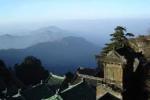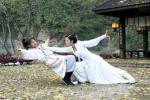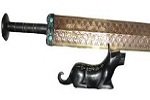Chinese Military Art by Sun Tzu
Chapter Four: Tactical Dipositions
Home ![]() Famous People From Ancient China
Famous People From Ancient China ![]() Sun Tzu
Sun Tzu ![]() Chinese Military Art
Chinese Military Art
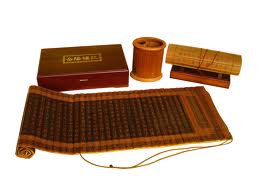
The Chinese military art book, Art of War, is the oldest military treatise in the world. It was writen by Sun Tzu ( also known as Sun Zi or Sun Wu) and has been translated into many languages.
Chapter Four: Tactical Dipositions
1. Sun Tzu said: The good fighters of old first put themselves beyond the possibility of defeat, and then waited for an opportunity of defeating the enemy.
2. To secure ourselves against defeat lies in our own hands, but the opportunity of defeating the enemy is provided by the enemy himself.
3. Thus the good fighter is able to secure himself against defeat, but cannot make certain of defeating the enemy.
4. Hence the saying: One may know how to conquer without being able to do it.
5. Security against defeat implies defensive tactics; ability to defeat the enemy means taking the offensive.
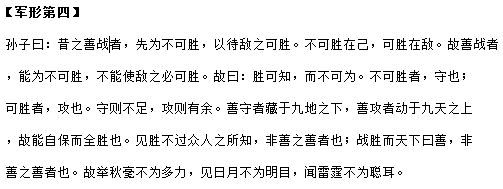 The Chinese Military Art by Sun Tzu: Tactical Dipositions text in Symlified Chinese, Part 1
The Chinese Military Art by Sun Tzu: Tactical Dipositions text in Symlified Chinese, Part 1
6. Standing on the defensive indicates insufficient strength; attacking, a superabundance of strength.
7. The general who is skilled in defense hides in the most secret recesses of the earth; he who is skilled in attack flashes forth from the topmost heights of heaven. Thus on the one hand we have ability to protect ourselves; on the other, a victory that is complete.
8. To see victory only when it is within the ken of the common herd is not the acme of excellence.
9. Neither is it the acme of excellence if you fight and conquer and the whole Empire says, "Well done!"
10. To lift an autumn hair is no sign of great strength; to see the sun and moon is no sign of sharp sight; to hear the noise of thunder is no sign of a quick ear.
11. What the ancients called a clever fighter is one who not only wins, but excels in winning with ease.
12. Hence his victories bring him neither reputation for wisdom nor credit for courage.
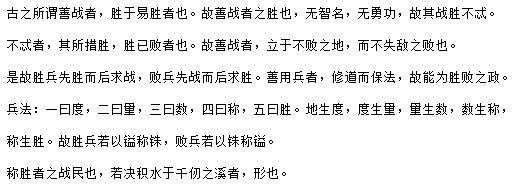 The Chinese Military Art by Sun Tzu: Tactical Dipositions, Text in Symlified Chinese, Part 2
The Chinese Military Art by Sun Tzu: Tactical Dipositions, Text in Symlified Chinese, Part 2
13. He wins his battles by making no mistakes. Making no mistakes is what establishes the certainty of victory, for it means conquering an enemy that is already defeated.
14. Hence the skillful fighter puts himself into a position which makes defeat impossible, and does not miss the moment for defeating the enemy.
15. Thus it is that in war the victorious strategist only seeks battle after the victory has been won, whereas he who is destined to defeat first fights and afterwards looks for victory.
16. The consummate leader cultivates the moral law, and strictly adheres to method and discipline; thus it is in his power to control success.
17. In respect of military method, we have, firstly, Measurement; secondly, Estimation of quantity; thirdly, Calculation; fourthly, Balancing of chances; fifthly, Victory.
18. Measurement owes its existence to Earth; Estimation of quantity to Measurement; Calculation to Estimation of quantity; Balancing of chances to Calculation; and Victory to Balancing of chances.
19. A victorious army opposed to a routed one, is as a pound's weight placed in the scale against a single grain.
20. The onrush of a conquering force is like the bursting of pent-up waters into a chasm a thousand fathoms deep.
Other Chapters of the Art of War by Sun Tzu:
- Laying Plans
- Waging War
- Attack by Stratagem
- Tactical Dipositions
- Energy
- Weak Points and Strong
- Maneuvering
- Variation in Tactics
- The Army on the March
- Terrain
- The Nine Situations
- The Attack by Fire
- The Use of Spies
* The version was translated by Lionel Giles in 1910.
Related Readings:
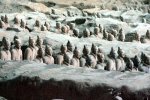
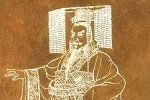

Famous People From Ancient China ![]() Sun Tzu
Sun Tzu ![]() Chinese Military Art: Laying Plans
Chinese Military Art: Laying Plans

New York Pass With More than 50 Sttractions

Southern California CityPASS saves you 32% for Disneyland, Universal Studios and 3 other attractions
